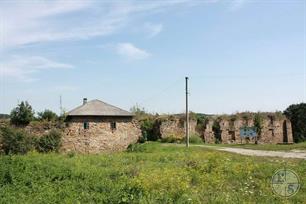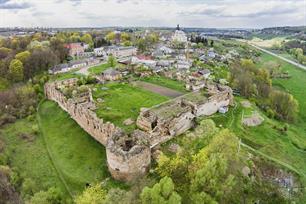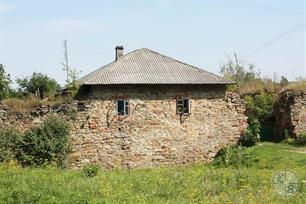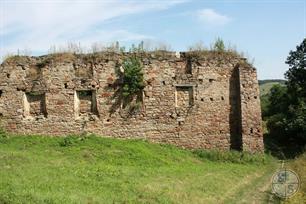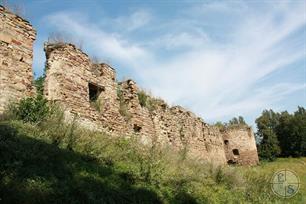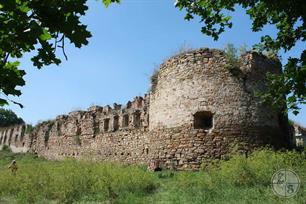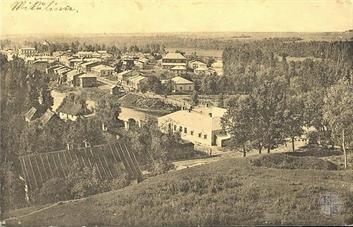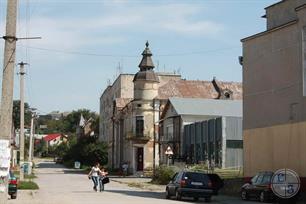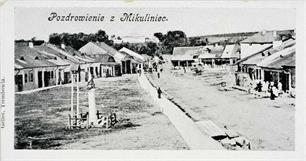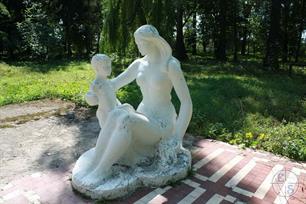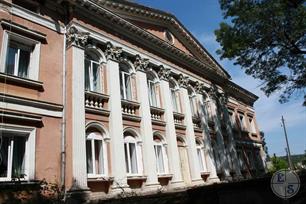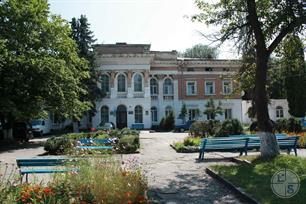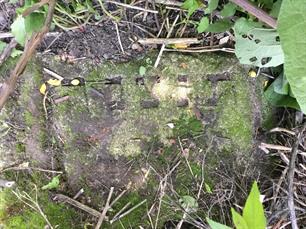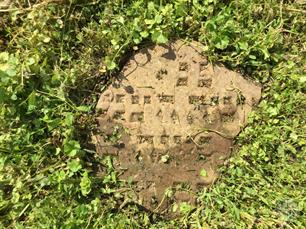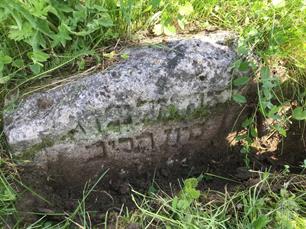Mykulyntsi
Ternopil district, Ternopil region
Sources:
- Pinkas Hakehillot Polin: Encyclopedia of Jewish Communities, Poland, Volume II, pages 169-177, published by Yad Vashem, Jerusalem. Translated by JewishGen, Inc.
Photo:
- Eugene Shnaider
- European Jewish Cemeteries Initiative. Mykulyntsi Jewish cemetery
- Українські Архітектурні Пам'ятки. Микулинці
- Pinkas Hakehillot Polin: Encyclopedia of Jewish Communities, Poland, Volume II, pages 169-177, published by Yad Vashem, Jerusalem. Translated by JewishGen, Inc.
Photo:
- Eugene Shnaider
- European Jewish Cemeteries Initiative. Mykulyntsi Jewish cemetery
- Українські Архітектурні Пам'ятки. Микулинці
In 1595, by royal charter, the village of Mikulince became a township. It was privately owned by the population. In 1674, the Turks besieged the town and captured it. A few residents were murdered and some were taken prisoners.
Economic development came to Mikulince during the first half of the nineteenth century. In 1820, health spas were built in the suburb of Konopkovka where mineral springs had been discovered as far back as the 17 th century .The spas brought to Mikulince patients from all over the eastern Galicia region and greatly helped the town's economy. At about the same time, a wool weaving factory was also established.
However, in the second half of the century, Mikulince's economic situation declined. With the introduction of the railroad, patients from Eastern Galicia now had access to health resorts all over the Austrian Empire, and the factory in Mikulince also did not succeed in competing against the more industrialized parts of the empire.
In 1903, a large fire broke out in the town and destroyed about three hundred buildings. There were also fatalities. A large portion of the population, about two thousand persons, remained homeless. The First World War and the economic situation in Poland during the 1920's and '30's brought a further decline in the economic situation of the town. As a result, the Population gradually decreased in the years preceding the Second World War.
The earliest record of Jewish settlement in Mikulince dates to 1716. That year, the Jewish community in the town paid a head tax of 482. In 1765, the community, including the Jews living in nearby villages, 485 persons.
Economic development came to Mikulince during the first half of the nineteenth century. In 1820, health spas were built in the suburb of Konopkovka where mineral springs had been discovered as far back as the 17 th century .The spas brought to Mikulince patients from all over the eastern Galicia region and greatly helped the town's economy. At about the same time, a wool weaving factory was also established.
However, in the second half of the century, Mikulince's economic situation declined. With the introduction of the railroad, patients from Eastern Galicia now had access to health resorts all over the Austrian Empire, and the factory in Mikulince also did not succeed in competing against the more industrialized parts of the empire.
In 1903, a large fire broke out in the town and destroyed about three hundred buildings. There were also fatalities. A large portion of the population, about two thousand persons, remained homeless. The First World War and the economic situation in Poland during the 1920's and '30's brought a further decline in the economic situation of the town. As a result, the Population gradually decreased in the years preceding the Second World War.
The earliest record of Jewish settlement in Mikulince dates to 1716. That year, the Jewish community in the town paid a head tax of 482. In 1765, the community, including the Jews living in nearby villages, 485 persons.
The Mikulince rabbis known to us were Rabbis Naftali Hirsch and Aharon Brode in 1780. Rabbi Abraham Arie Babad was rabbi of Mikulince in the middle of the nineteenth century and died in 1860. The next to hold the rabbinate, Haim Babad, died in 1889. After that, the rabbinate in Mikulince passed from father to son: Rabbi Moshe and Rabbi Haim Babad who died in 1906; his son Rabbi Yehoshua Heshel Babad who was rabbi of Mikulince from 1906 to 1912 and his son Rabbi Yosef Ben-Zion Babad who was killed during the Second World War in 1942 or 1943.
The 1903 fire seriously hurt the Jews of Mikulince, who comprised two thirds of the town's total population. Among other things, the synagogue and other houses of prayer were burned, as was the school founded by Baron Hirsch. In spite of this, the Jewish community picked up the pieces and rebuilt.
The Austrian authorities helped. In 1910, the synagogue again stood, this time built of brick, and its magnificent interior was restored. The study house, eight prayer houses and the Baron Hirsch School were also rebuilt.
Before the First World War, Jews served as mayors of the town. (Mayor Kurtz for example) and in other important positions such as judgeships (Judge Glick) and running the railway station. When war broke out, many Jews fled to neighboring villages and to the cities nearby. Most returned to Mikulince when it was occupied by the Russians, but some Mikulince Jews traveled to other cities in Austria and remained there throughout the war.
The 1903 fire seriously hurt the Jews of Mikulince, who comprised two thirds of the town's total population. Among other things, the synagogue and other houses of prayer were burned, as was the school founded by Baron Hirsch. In spite of this, the Jewish community picked up the pieces and rebuilt.
The Austrian authorities helped. In 1910, the synagogue again stood, this time built of brick, and its magnificent interior was restored. The study house, eight prayer houses and the Baron Hirsch School were also rebuilt.
Before the First World War, Jews served as mayors of the town. (Mayor Kurtz for example) and in other important positions such as judgeships (Judge Glick) and running the railway station. When war broke out, many Jews fled to neighboring villages and to the cities nearby. Most returned to Mikulince when it was occupied by the Russians, but some Mikulince Jews traveled to other cities in Austria and remained there throughout the war.
The Russian authorities' attitudes toward the Jews of Mikulince were tolerable. The Jews were not persecuted but were conscripted for difficult public works' jobs such as building fortifications, street cleaning, etc. Their economic situation also deteriorated because of the change of currency, expropriation of houses and property for military use and other economic measures. Commerce and industry were at a standstill. Even after the disintegration of the Austrian Empire, Mikulince's Jews did not suffer from the Ukrainians or later (in 1920) from the Bolsheviks. They, too, limited themselves to expropriating property and drafting the men for public works.
However, when the Polish Army units under General Haller's command, they attacked the Jews, cut beards and side locks and insulted Jews in other ways. Under Polish rule, the economic situation of Mikulince's Jews deteriorated further and their number continued to decline as more and more of them left town.
Under Polish rule, the Jews continued to support themselves primarily through commerce -selling the agricultural produce of neighboring villages in larger markets and selling their own manufactured items to the farmers. There were a few wholesalers and a few wealthy exporters who dealt in cattle, eggs, wheat and, above all, fabrics. A few Jews owned flour and grits mills, beer breweries and taverns.
During the period between the two world wars, there were also two Jewish doctors, three Jewish lawyers a Jewish judge and a Jewish pharmacist in Mikulince.
There was a Jewish bank in Mikulince. In 1929, a fund for interest-free loans was established and between 1933 and 1937 the loans given by the fund averaged 3126 zloty a year. The occupational distribution of the borrowers, according to data from 1936 and 1937, was as follows: 109 small merchants, 27 craftsmen, twenty laborers, four farmers and 26 others.
However, when the Polish Army units under General Haller's command, they attacked the Jews, cut beards and side locks and insulted Jews in other ways. Under Polish rule, the economic situation of Mikulince's Jews deteriorated further and their number continued to decline as more and more of them left town.
Under Polish rule, the Jews continued to support themselves primarily through commerce -selling the agricultural produce of neighboring villages in larger markets and selling their own manufactured items to the farmers. There were a few wholesalers and a few wealthy exporters who dealt in cattle, eggs, wheat and, above all, fabrics. A few Jews owned flour and grits mills, beer breweries and taverns.
During the period between the two world wars, there were also two Jewish doctors, three Jewish lawyers a Jewish judge and a Jewish pharmacist in Mikulince.
There was a Jewish bank in Mikulince. In 1929, a fund for interest-free loans was established and between 1933 and 1937 the loans given by the fund averaged 3126 zloty a year. The occupational distribution of the borrowers, according to data from 1936 and 1937, was as follows: 109 small merchants, 27 craftsmen, twenty laborers, four farmers and 26 others.
The Second World War
With the outbreak of war and during the period of Soviet rule, the Jewish population of Mikulince increased because of refugees from Western Poland and the exile by Soviet authorities of several Jews from larger cities to Mikulince. When hostilities between the Germans and the Soviets began in 1941, the Mikulince population suffered from the German shellings because a Soviet airfield was located nearby.
The German legions occupied the town on July 5, 1941. After the Soviet Army retreated, and even before the Germans entered the town, the local Ukrainians began atrocities against the Jews.
When the Germans came into town, they demanded that the Ukrainian mayor bring them two Jews whom they could execute for show. The two Jews were shot that very evening in public. The pogrom, which had begun beforehand, now continued with the participation of German soldiers, Ukrainian police and Ukrainian farmers from the surrounding area who flocked to town for the purpose. They all stormed Jewish homes, robbing and murdering.
The Ukrainian police brought a group of between twelve and twenty Jews to the outskirts of town. The Jews were told they would work in the beer brewery. When they got there, they were commanded to dig a large grave, supposedly to bury a dead horse. The Jews were murdered with spades and were thrown into the hole, some while still alive. On top of the pile of bodies, the Ukrainians threw the horse's corpse.
At the same time, all the Jews were rounded up to clean streets and roads and to bury the pogrom victims in a mass grave in the cemetery.When the work was done, the Jews were led to the bridge over the Seret River. The Ukrainians planned to murder them then and there, but a German officer came along and prevented the murder. The Jews were beaten but their lives were saved.
The mass pogrom ended but a campaign of arrests against the intelligentsia the wealthy and those formerly active in public life. Some managed to bribe their way out of jail but eighteen were shot to death. Among them were D. Marcus, Wolfenhart, Goldstein and her daughter. The same laws which the Germans used against Jews everywhere else applied in Mikulince: the requirement to hand over gold and other valuables, the obligation of men and women to work, and the requirement that Jews wear the yellow star of David.
With the outbreak of war and during the period of Soviet rule, the Jewish population of Mikulince increased because of refugees from Western Poland and the exile by Soviet authorities of several Jews from larger cities to Mikulince. When hostilities between the Germans and the Soviets began in 1941, the Mikulince population suffered from the German shellings because a Soviet airfield was located nearby.
The German legions occupied the town on July 5, 1941. After the Soviet Army retreated, and even before the Germans entered the town, the local Ukrainians began atrocities against the Jews.
When the Germans came into town, they demanded that the Ukrainian mayor bring them two Jews whom they could execute for show. The two Jews were shot that very evening in public. The pogrom, which had begun beforehand, now continued with the participation of German soldiers, Ukrainian police and Ukrainian farmers from the surrounding area who flocked to town for the purpose. They all stormed Jewish homes, robbing and murdering.
The Ukrainian police brought a group of between twelve and twenty Jews to the outskirts of town. The Jews were told they would work in the beer brewery. When they got there, they were commanded to dig a large grave, supposedly to bury a dead horse. The Jews were murdered with spades and were thrown into the hole, some while still alive. On top of the pile of bodies, the Ukrainians threw the horse's corpse.
At the same time, all the Jews were rounded up to clean streets and roads and to bury the pogrom victims in a mass grave in the cemetery.When the work was done, the Jews were led to the bridge over the Seret River. The Ukrainians planned to murder them then and there, but a German officer came along and prevented the murder. The Jews were beaten but their lives were saved.
The mass pogrom ended but a campaign of arrests against the intelligentsia the wealthy and those formerly active in public life. Some managed to bribe their way out of jail but eighteen were shot to death. Among them were D. Marcus, Wolfenhart, Goldstein and her daughter. The same laws which the Germans used against Jews everywhere else applied in Mikulince: the requirement to hand over gold and other valuables, the obligation of men and women to work, and the requirement that Jews wear the yellow star of David.
In the cultural-political sphere, the Zionists were very active. The local Zionist organization already existed in 1898. In 1903, a social club of the intelligentsia, with a Zionist orientation, was active organizing: shows, parties and events of a cultural and educational nature.
In 1912, Hamizrachi organized charity activities under the sponsorship of "Pat La orchim". An indication of the influence, which Zionism had in Mikulince, can be gauged from the fact that in the elections to the Polish parliament in 1922 most of the 699 Jews with the right to vote supported the National List. A report from 1923 mentions an "Ezrah" branch in Mikulince and the activities of the local "hehalutz" branch are mentioned in a report from 1924.
In the 20's, a "Hitachdut" branch was also established and included a library and dramatic club. In the 1930's, the Revisionists and "Hitachdut Poalei Zion" organized branches in Mikulince.
In 1933 and 1934, branches of "Achvah" and "Young Achvah" were founded and they ran a Kibbutz training program in Vola Mazoviecka. "Achvah" also ran a library, a drama club, an orchestra and the Herzliya Sports Club. The "Hapoel" sports club also existed in Mikulince.
"Hashomer Hatsair" resumed its work in Mikulince in 1936 and also had a library. Its graduates organized into "stam Halutz" Zionist youth clubs, "Hashachar" and "Gordonia", also worked in Mikulince. "Gordonia" was the strongest of the youth organizations. The Zionists opened a club in Mikulince; called Der Verein.
Under Zionist influence, courses sponsored by the Association of Jewish Elementary and High Schools in Lvov were offered in Mikulince itself. There was also a Hebrew school, apparently a sequel to Hebrew courses, which began in 1907.
The organization "Ivriah" opened a branch in Mikulince including a club and Hebrew courses. In elections to the 15 th , 17 th , 18 th and 19 th Zionist Congresses, the "Hitachdut" or the League for a Working Land of Israel got most of the Mikulince votes. The General Zionist were in second place, and third (with a much smaller number of votes) was the Mizrachi.
During the period between the two world wars, hassids had great influence in Mikulince, particularly the Rijin, Husyatin and Chortkov hassids. The Rijin hassids were the basis for the "agudat Yisrael" branch established in Mikulince after the First World War. There was a bitter struggle between Agudat Yisrael and the Zionists in Jewish community elections. In 1933, the Zionists won the elections and Agudat Yisrael went to the authorities and asked that the Jewish community leadership be disbanded. They succeeded. A commissar was appointed to head the Jewish community but the real power was in the hands of Agudat Yisrael.
In order to insure their continued hegemony in the Jewish community, Agudat Yisrael decided to deny clean-shaven Jews the right to vote in the next community elections. They disqualified 203 voters from among the 600 who had the right to vote, including those who shaved with a razor. The victims complained to the district authorities in Tarnopol. In the 1927 elections to the Mikulince town council, the Jews got 17 seats (including three held by Zionists) out of the 48 seats on the council. In the 1933 elections, a separate slate of Jewish candidates was not approved but three Jews were elected on the Sanacsia slate, two of them Zionists.
In 1933, the anti-Semitic mayor Kazimovski made the Jews' lives miserable. He discriminated particularly against the Jews in need of welfare assistance and made it difficult for them to get free medical care.
In 1912, Hamizrachi organized charity activities under the sponsorship of "Pat La orchim". An indication of the influence, which Zionism had in Mikulince, can be gauged from the fact that in the elections to the Polish parliament in 1922 most of the 699 Jews with the right to vote supported the National List. A report from 1923 mentions an "Ezrah" branch in Mikulince and the activities of the local "hehalutz" branch are mentioned in a report from 1924.
In the 20's, a "Hitachdut" branch was also established and included a library and dramatic club. In the 1930's, the Revisionists and "Hitachdut Poalei Zion" organized branches in Mikulince.
In 1933 and 1934, branches of "Achvah" and "Young Achvah" were founded and they ran a Kibbutz training program in Vola Mazoviecka. "Achvah" also ran a library, a drama club, an orchestra and the Herzliya Sports Club. The "Hapoel" sports club also existed in Mikulince.
"Hashomer Hatsair" resumed its work in Mikulince in 1936 and also had a library. Its graduates organized into "stam Halutz" Zionist youth clubs, "Hashachar" and "Gordonia", also worked in Mikulince. "Gordonia" was the strongest of the youth organizations. The Zionists opened a club in Mikulince; called Der Verein.
Under Zionist influence, courses sponsored by the Association of Jewish Elementary and High Schools in Lvov were offered in Mikulince itself. There was also a Hebrew school, apparently a sequel to Hebrew courses, which began in 1907.
The organization "Ivriah" opened a branch in Mikulince including a club and Hebrew courses. In elections to the 15 th , 17 th , 18 th and 19 th Zionist Congresses, the "Hitachdut" or the League for a Working Land of Israel got most of the Mikulince votes. The General Zionist were in second place, and third (with a much smaller number of votes) was the Mizrachi.
During the period between the two world wars, hassids had great influence in Mikulince, particularly the Rijin, Husyatin and Chortkov hassids. The Rijin hassids were the basis for the "agudat Yisrael" branch established in Mikulince after the First World War. There was a bitter struggle between Agudat Yisrael and the Zionists in Jewish community elections. In 1933, the Zionists won the elections and Agudat Yisrael went to the authorities and asked that the Jewish community leadership be disbanded. They succeeded. A commissar was appointed to head the Jewish community but the real power was in the hands of Agudat Yisrael.
In order to insure their continued hegemony in the Jewish community, Agudat Yisrael decided to deny clean-shaven Jews the right to vote in the next community elections. They disqualified 203 voters from among the 600 who had the right to vote, including those who shaved with a razor. The victims complained to the district authorities in Tarnopol. In the 1927 elections to the Mikulince town council, the Jews got 17 seats (including three held by Zionists) out of the 48 seats on the council. In the 1933 elections, a separate slate of Jewish candidates was not approved but three Jews were elected on the Sanacsia slate, two of them Zionists.
In 1933, the anti-Semitic mayor Kazimovski made the Jews' lives miserable. He discriminated particularly against the Jews in need of welfare assistance and made it difficult for them to get free medical care.
 |
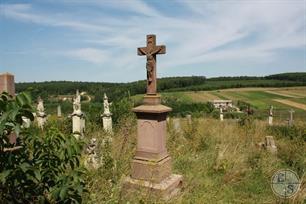 |
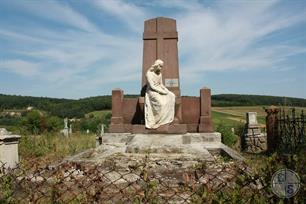 |
| Baroque style church is the most beautiful building in the village | Near the church - the ancient Polish cemetery | The last housewife of Mykulyntsis, Countess Juzefa Rey, was buried here |
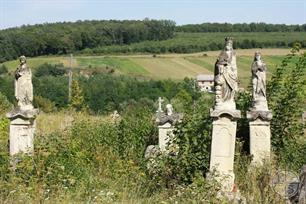 |
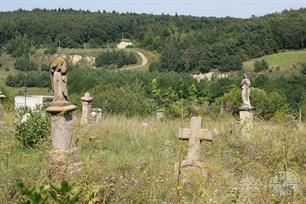 |
|
At the end of 1941, the Jews were ordered to destroy their synagogue, to remove the head stones in the cemetery and to use the stones to pave the streets of Mikulince.
In the winter of 1941-42, the Jews of Mikulince were ordered, as were Jews elsewhere, to hand over to the Germans any fur they possessed. The robbery of Jewish property in different ways and different excuses continued ceaselessly but increased in the spring of 1942. Now, the Jews were ordered to give the Germans all the food they had and in addition those who brought the food to the collection point were harassed.
At the same time, a group of German policemen from Tarnopol arrived in Mikulince. They went from one Jewish home to the next, taking the best of what they found in each. From time to time, Jews were killed for various "crimes". For example, the Germans would shoot Jews whom they caught in the neighboring villages selling their property or buying food. The Jewish men of Mikulince were seized and taken to labor camps.
Jewish men and women from Mikulince also worked on farms in the area or in the village of Mishkovitse. Conditions there were slightly better; the Jews were not victimized and did not suffer from hunger.
Near some of the farms, camps were built where the Jewish laborers lived, and they were occasionally able to visit their families in Mikulince. The Judenrat, headed by Attorney Yegendorf, helped the Germans by providing manpower and in collecting fines (property) from the population. Yagendorf's assistant was Zaltzman. We know the names of the members of the Judenrat: Morgenstern, Walfisch, Horowitz, Margulis. There was no fenced-in ghetto in Mikulince, but the Jews were ordered to concentrate in a particular part of town near the bank of the river.
In July and August, 1942, the Jews of Mikulince learned of the destruction of Jewish settlements in the entire region. Those who could do so prepared hiding places.
On August 28, 1942, German and Ukrainian police arrived from Tarnopol, surrounded the Jewish quarter, forced the Jews out of their houses and put them into trucks. The old and sick were murdered. on the spot. There were also many casualties among those who tried to escape. Most of those who hid in the nearby forest were killed. The "action" continued all day; Twelve hundred Jews were brought to the railroad station and from there by train to the extermination camp at Belsez. Between eighty and a hundred Jews were killed in Mikulince itself during the "action". Afterward, the Christian population stormed the Jewish homes and looted them.
A few dozen Jews did manage to hide and to avoid being sent to the extermination camps. The Germans left them alone for a few weeks and exploited them for cleaning the vacated apartments and for sorting the looted goods for transport to the local administration.
In late September or early October 1942, the Germans decided that Mikulince must be free of Jews. The remaining Jews were therefore ordered to move to the Tarnopol ghetto. According to another version, the Jews left in Mikulince were ordered at the end of October 1942 to move to the ghetto in Trembovla until November 1, 1942. The Jews therefore loaded what remained of their property into wagons and left Mikulince.
Since the authorities did not supervise their exodus, the Jews went to other towns in the area where there were still remnants of Jewish communities. There, too, however, the same fate awaited all of them.
In the winter of 1941-42, the Jews of Mikulince were ordered, as were Jews elsewhere, to hand over to the Germans any fur they possessed. The robbery of Jewish property in different ways and different excuses continued ceaselessly but increased in the spring of 1942. Now, the Jews were ordered to give the Germans all the food they had and in addition those who brought the food to the collection point were harassed.
At the same time, a group of German policemen from Tarnopol arrived in Mikulince. They went from one Jewish home to the next, taking the best of what they found in each. From time to time, Jews were killed for various "crimes". For example, the Germans would shoot Jews whom they caught in the neighboring villages selling their property or buying food. The Jewish men of Mikulince were seized and taken to labor camps.
Jewish men and women from Mikulince also worked on farms in the area or in the village of Mishkovitse. Conditions there were slightly better; the Jews were not victimized and did not suffer from hunger.
Near some of the farms, camps were built where the Jewish laborers lived, and they were occasionally able to visit their families in Mikulince. The Judenrat, headed by Attorney Yegendorf, helped the Germans by providing manpower and in collecting fines (property) from the population. Yagendorf's assistant was Zaltzman. We know the names of the members of the Judenrat: Morgenstern, Walfisch, Horowitz, Margulis. There was no fenced-in ghetto in Mikulince, but the Jews were ordered to concentrate in a particular part of town near the bank of the river.
In July and August, 1942, the Jews of Mikulince learned of the destruction of Jewish settlements in the entire region. Those who could do so prepared hiding places.
On August 28, 1942, German and Ukrainian police arrived from Tarnopol, surrounded the Jewish quarter, forced the Jews out of their houses and put them into trucks. The old and sick were murdered. on the spot. There were also many casualties among those who tried to escape. Most of those who hid in the nearby forest were killed. The "action" continued all day; Twelve hundred Jews were brought to the railroad station and from there by train to the extermination camp at Belsez. Between eighty and a hundred Jews were killed in Mikulince itself during the "action". Afterward, the Christian population stormed the Jewish homes and looted them.
A few dozen Jews did manage to hide and to avoid being sent to the extermination camps. The Germans left them alone for a few weeks and exploited them for cleaning the vacated apartments and for sorting the looted goods for transport to the local administration.
In late September or early October 1942, the Germans decided that Mikulince must be free of Jews. The remaining Jews were therefore ordered to move to the Tarnopol ghetto. According to another version, the Jews left in Mikulince were ordered at the end of October 1942 to move to the ghetto in Trembovla until November 1, 1942. The Jews therefore loaded what remained of their property into wagons and left Mikulince.
Since the authorities did not supervise their exodus, the Jews went to other towns in the area where there were still remnants of Jewish communities. There, too, however, the same fate awaited all of them.
Year - Total Population - Jews
1765 - ???? - 427
1880 - 3750 - 2411
1890 - 3835 - 2468
1900 - 3660 - 2284
1910 - 3511 - 2137
1921 - 3217 - 1891
1931 - ???? - 1790
1765 - ???? - 427
1880 - 3750 - 2411
1890 - 3835 - 2468
1900 - 3660 - 2284
1910 - 3511 - 2137
1921 - 3217 - 1891
1931 - ???? - 1790

- Home
- Shtetls
- Vinnytsia region
- Volyn region
- Dnipro region
- Donetsk region
- Zhytomyr region
- Zakarpattia region
- Zaporizhzhia region
- Ivano-Frankivsk region
- Kyiv region
- Kropyvnytskyi region
- Luhansk region
- Lviv region
- Mykolayiv region
- Odessa region
- Poltava region
- Rivne region
- Sumy region
- Ternopil region
- Kharkiv region
- Kherson region
- Khmelnytskyi region
- Chernihiv region
- Chernivtsi region
- Cherkasy region
- Crimea
- Synagogues
- Cemeteries
- Objects & guides
- Gallery
- History
- Contact
Jewish towns of Ukraine
Jewish towns of Ukraine
My shtetl
My shtetl
Donate
